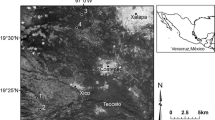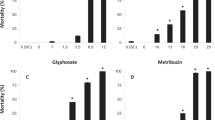Abstract
Sub-adult African clawed frogs (Xenopus laevis) were fed pentachlorophenol (PCP)-injected mealworms containing 64.8 to 2604 ug of PCP per gram of worm for 27 days. There was no mortality and no significant bioaccumulation of PCP in the frogs. After three weeks, frogs fed 2,604 Rg/g of PCP ceased eating. The no observed adverse effects level (NOAEL) based on significantly reduced food consumption (PCP-injected mealworms) was 638 μg/g. This corresponded to a NOAEL based on PCP intake of about 8 μg PCP/ g frog/day. A toxicity threshold model estimated that about 800 μg/L of waterborne PCP may be a threshold for adverse effects in Xenopus or similar amphibians. Further study is needed to verify threshold estimates.
Similar content being viewed by others
References
Bantle JA, Fort DJ, James BL (1989) Identification of developmental toxicants using frog embryo assayXenopus (Fetax). Hydrobiologia 188/189:577–585
Bevenue A, Beckman H (1967) Pentachlorophenol: A discussion of its properties and its occurrence as a residue in human and animal tissues. Residue Rev 19:83–114
Computer Sciences Corporation (1988) Users guide for a computer program for Dunnett's procedure in the analysis of data from short term toxicity tests with aquatic organisms. U.S. Environmental Protection Agency, Cincinnati, OH
Duellman WE, Treub L (1986) The biology of amphibians. Mcgraw-Hill NY
Dunnett, CW (1955) A multiple comparison procedure for comparing several treatments with a control. J Amer Stat Assoc 50:1096–1121
Edmisten GE, Bantle JA (1982) Use ofXenopus laevis in 96-hour flow through tests with naphthalene. Bull Environ Contain Toxicol 29:392–399
Eisler R (1989) Pentachlorophenol hazards to fish, wildlife and invertebrates: A synoptic review. U.S. Fish Wildl Ser Biol Rep 85(1.17). Pautuxent Wildlife Research Center, Laurel, MD
Ewer RF (1952) The effects of posterior pituitary extracts on water balance inBufo carens andXenopus laevis, together with some general considerations of anuran water economy. J Exp Zool 29:429–439
Fisher SW (1990) The pH dependent accumulation of PCP in aquatic microcosms with sediment. Aquat Toxicol 18:199–218
Hall KJ, Jacob C (1988) Bioconcentration of chlorophenols by leeches and their use asin situ biological monitors. Water Pollut Res J Can 23:69–87
Hall RJ, Swineford D (1980) Toxic effects of endrin and toxaphene on the southern leopard frogRana sphenocephala. Environ Pollut (Ser A) 23:53–65
Hedtke SF, Arthur JW (1985) Evaluation of a site-specific water quality criterion for pentachlorophenol using outdoor experimental streams. In Cardwell RD, Purdy R, Balmer RC (eds) Aquatic Toxicology and Hazard Assessment: Seventh Symposium, ASTM STP 854. American Society for Testing and Materials, Philadelphia, pp 551–564
Hill DF (1986) Principles of pesticide formulation analysis. In: Zweig G, Sherma J (eds) Analytical methods for pesticides and plant growth regulators. Academic Press, NY, Vol XV, Chap 5, pp 145–146
Hodson PV, Blunt BR (1981) Temperature-induced changes in pentachlorophenol chronic toxicity to early life stages of rainbow trout. Aquatic Toxicol 1:113–127
Lee H, Hong-you RL, Chan ASY (1985) Analysis of phenols by chemical derivitization. IV. Rapid and sensitive method for analysis of 21 chlorophenols by improved chloroacetylation procedure. J Assoc Offic Anal Chem 68:442–426
Mayer FL, Ellersieck MR (1986) Manual of acute toxicity: Interpretation and data base for 410 chemicals and 66 species of freshwater animals. U.S. Fish Wildl Serv Resource Publ 160, Washington,
McKim J, Schmieder P, Veith G (1985) Absorption dynamics of organic chemical transport across trout gills as related to octanolwater partition coefficient. Toxicol Appl Pharmacol 77:1–10
Miller JD (1978) Observations on the diets ofRana pretiosa, Rana pipiens andBufo boreas from western Montana. Northwest Sci 52:243–249
Nebeker AV, Griffis WL, Stutzman TW, Schuytema GS, Carey LA, Scherer SM (1992) Effects of aqueous and dietary exposure of dieldrin on survival, growth and bioconcentration in mallard ducklings. Environ Toxicol Chem 11:687–699
Peterson JA, Nebeker AV (1992) Estimation of waterborne selenium concentrations that are toxicity thresholds for wildlife. Arch Environ Toxicol Chem 23:154–162
Schuytema GS, Nebeker AV, Griffis WL, Wilson KN (1991) Teratogenesis, toxicity and bioconcentration in frogs exposed to dieldrin. Arch Environ Contain Toxicol 21:332–350
Seiler JP (1991) Pentachlorophenol. Mutat Res 257:27–47
Spehar RL, Nelson HP, Swanson MJ, Renoos JW (1985) Pentachlorophenol toxicity to amphipods and fathead minnows at different test pH values. Environ Toxicol Chem 4:389–397
Stebbins RC (1985) A field guide to western reptiles and amphibians. Houghton Mifflin, Boston, MA
Stephan CE, Mount DI, Hansen DJ, Gentile JH, Chapman GA, Brungs WA (1985) Guidelines for deriving numerical national water quality criteria for the protection of aquatic organisms and their uses. NTIS PB85-227049. U.S. Environmental Protection Agency, Office of Research and Development, Washington DC
Thurston RV, Gilfoil TA, Meyn EL, Zajdel RK, Aoki TI, Veith GD (1985) Comparative toxicity of ten organic chemicals to ten common aquatic animals. Water Res 19:1145–1155
Tracy CR (1976) A model of the dynamic exchanges of water and energy between a terrestrial amphibian and its environment. Ecol Monogr 46:293–326
Truhaut R, Vitte G, Boussemart E (1953) Recherches sur la toxicologie du pentachlorophenol. 1. Proprietes, caracterisation et dosage dans les milieux biologiques. Phytiatrie-Phytopharmacie 1:3–11
U.S. Environmental Protection Agency (1979) Methods for chemical analysis of water and waste. EPA 600/4-79-020. Environmental Monitoring and Support Laboratory, Cincinnati, OH
(1980) Manual of analytical methods for the analyses of pesticides in humans and environmental samples. EPA 600/8-80-038. Health Effects Research Laboratory, Research Triangle Park, NC
(1986) Ambient water quality criteria for pentachlorophenol—1986. EPA 440/5-86-009. Office of Water Regulations and Standards, Criteria and Standards Division, Washington, DC
Williams B, Marcy S, Gerould S (1989) Water quality criteria to protect wildlife resources. EPA 600/3-89-067. U.S. Environmental Protection Agency, Corvallis, OR
Wisconsin Department of Natural Resources (1988) Technical support document for chapter NR. 105 of the Wisconsin Administrative Code. Wisconsin Department of Natural Resources, Madison, WI
Zischke JA, Arthur JW, Hermanutz RO, Hedtke SF, Helgen JC (1985) Effects of pentachlorophenol on invertebrates and fish in outdoor experimental channels. Aquat Toxicol 7:37–58
Author information
Authors and Affiliations
Rights and permissions
About this article
Cite this article
Schuytema, G.S., Nebeker, A.V., Peterson, J.A. et al. Effects of pentachlorophenol-contaminated food organisms on toxicity and bioaccumulation in the frogXenopus laevis . Arch. Environ. Contam. Toxicol. 24, 359–364 (1993). https://doi.org/10.1007/BF01128734
Received:
Revised:
Issue Date:
DOI: https://doi.org/10.1007/BF01128734




